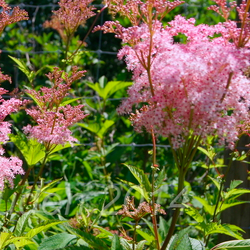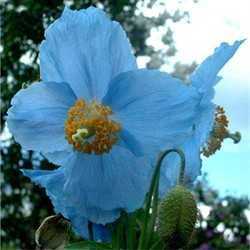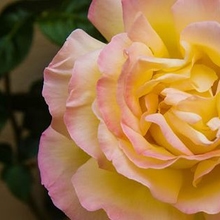Filipendula, commonly called meadowsweet, have long been grown as popular garden ornamentals in temperate climates (most are hardy to zone 3). Before becoming popular as a garden plant, meadowsweet was used as a herbal. Filipendula vulgaris was used to flavour mead. It was from the flowerhead of F. ulmaria that salicylic acid was first derived (and I thought it was from willow!). Even modern day herbalists use Filipendula to relieve pain from arthritis, headache, peptic ulcers and gastritis. The rhizomes and young leaves of F. vulgaris are sometimes eaten in salads. Filipendula are more than just a pretty flower!
There are only five species which are relatively common in cultivation although there are some 15 species found in the wild. Most hail from China but they also occur in Europe and North America. Although you wouldn’t think it, they are members of the Rose Family. Plants vary in size but are generally plants for the back-of-the-border. Their leaves are relatively large, pinnate to maple-like and sharply serrated. The flowers, which are produced mid-summer, are arranged in a plume-like display, reminiscent of goat’s-beard, Aruncus (which are relatives). Flowers vary from white to deep pink and individual blossoms are not unlike those of Spiraea, some which are also, incidentally, called meadowsweet. In the wild, they grow in damp meadows, along streams and the edges of damp, deciduous forests. In the garden, provide them with a moist site and organic-rich soil that is one the acidic side. Full sun will result in the most robust plants although in warmer regions, dappled shade is fine. A notable exception is F. vulgaris, which is more tolerant to dry conditions and alkaline soil.
There are only two species of Filipendula native to North America, with only one commonly grown in our gardens; F. rubra, commonly called Queen of the Prairie. This species is native to eastern North America. As it happens, this is the giant in the genus, with plants towering to 2.5 m (8 feet). As a bold statement in the border, it is hard to top F. rubra. Their flowers vary from nearly white to mid-pink. The cultivar ‘Venusta’ has particularly deep pink flowers and was awarded an Award of Garden Merit by the RHS in 1993. The other North American native is F. occidentalis or Queen of the Forest. This species has a very restricted range along Coast Range streams of Oregon and Washington. It appears quite similar to F. rubra, is more shade-tolerant but challenging to grow due to its high moisture requirements.


Details of Filipendula rubra
There are two species native to Europe, F. vulgaris (aka F. hexapetala) and F. ulmaria. Both of these species are now naturalized in eastern North America. Filipendula vulgaris is commonly known as dropwort. It has finely-pinnate foliage somewhat like those of yarrow, with most leaves being basal. It is relatively small among the Filipendula, reaching 60-90 cm (2-3 feet). The cultivar ‘Multiplex’ is a sterile, double-flowered selection. Filipendula ulmaria, called Queen of the Meadow, will reach upwards to 1.2 m (4 feet) with coarser foliage. This species ranges across Europe to China. There are several named selections; ‘Flore Pleno’ has double flowers, ‘Aurea’ has yellow foliage while ‘Variegata’ has deep green leaves with striking, central yellow variegation. Both F. vulgaris and F. ulmaria have creamy-white flowers.



Selections of F. ulmaria include 'Flore pleno', 'Variegata' and 'Aurea'
China and Japan are home to several species of Filipendula but only one is common in cultivation, F. purpurea or Japanese meadowsweet. It is believed that this species is, in fact, a hybrid derived from F. multijuga, since no plants have ever been found in the wild. This plant appears like a smaller version of F. rubra in regards to leaves but its flowers are the deepest pink of any Filipendula. Plants reach upwards to 1.2 m (4 feet). Most authorities rate this selection hardy to zone 4. It was also awarded the Award of Garden Merit by the RHS in 1993. The selection ‘Elegans’ is more dwarf, reaching about 45 cm (18 inches).


Above are F. purpurea and F. purpurea 'Alba'
One other Filipendula sometimes found is the hybrid called ‘Kahome’ (aka ‘Kakome’). This plant is a smaller-leaved, smaller-flowered version of F. purpurea with deep-pink flowers. Plants reach 30-60 cm (1-2 feet). This hybrid is probably derived from F. multijuga as well,and may, in fact, simply be a small version of the popular F. purpurea. It is often erroneously offered in the trade as F. palmata ‘Nana’ which, in truth, is a white-flowered species (that is how I inadvertently got my ‘Kahome’!).


Filipendula 'Kahome' and its fall foliage
From what I have read, the remaining Filipendula species (all east Asian) are also garden-worthy, although rarely encountered. For completeness I will list them here in case you ever come across them. They include F. camtschatica, F. glaberrima, F. palmata, F. yezoensis, F. auriculata, F. angustiloba, F. vestita, F. kiraishiensis, F. tsugowoi and F. formosa.
I would like to thank the following people for the use of their pictures: Joy (F. ulmaria 'Variegata'), rebecca101 (F. purpurea 'Alba') and victorgardener (F. ulmaria 'Aurea').

















